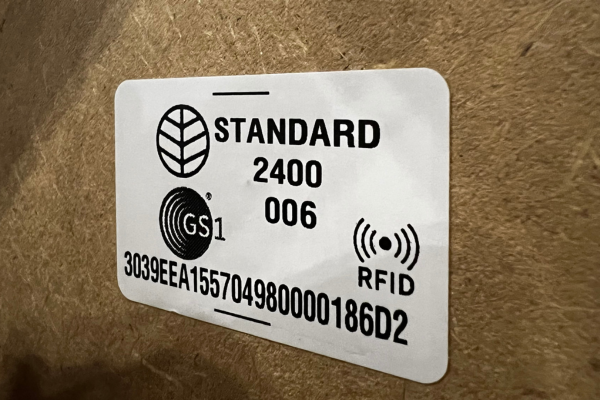The construction industry faces significant challenges in becoming more efficient, increasing safety, improving productivity, and lowering costs.
New legislation is also fuelling a growing demand for consistent, accurate, and trusted data on the procurement and management of materials at every step of the supply chain.
By providing stakeholders with a common language for capturing and sharing data on buildings, equipment and materials, GS1 standards have the power to increase the visibility, traceability, and safety.
The construction industry must digitalise if it is to deliver lasting change and a clear pathway for the future. GS1 standards can power this digitalisation, keeping industry informed and consumers protected with data they can trust.
Benefits of using GS1 standards in construction
Sustainability and traceability
GS1 standards create more efficient information flows with greater transparency through the value chain.
Digitisation and automation
Enable the digital sharing of interoperable data. Having full control over delivery and distribution saves time and reduces costs.
Comply with legislation
GS1 standards help businesses meet challenging regulatory and industry demands, providing increased security and trust, regardless of where you sit in the supply chain.

As a member of GS1 UK, we see the provision of a GTIN is incredibly important in supporting a number of our business processes and a key ingredient in our strategic data roadmap, which will benefit our customers in the future."
Robert Barbour
Group data & insights director

The golden thread
The Building Safety Act 2022 has been put in place with the aim of enhancing regulation around building safety and construction.
To facilitate what many refer to as the ‘golden thread of data’, it is essential for the construction industry to collaborate and recognise the need for a common product identifier.
This will enable a consistent approach to the sharing of trusted data across the entire supply chain, from manufacturer to retailer and onto the building site.
The golden thread of data starts with the ability for everyone, at any stage in the manufacture or usage of construction materials, to easily identify a product using a ‘common product language’.
Using GS1 standards and the Global Trade Item Number (GTIN) as the unique product identifier will provide the first critical piece of the thread. This product data can then be used to build data sets that will enable stakeholders to make more informed decisions and meet new regulatory requirements for traceability, interoperability, accessibility, verifiable and secure data.
Traceability and interoperability
There are a number of GS1 Identification Keys that are used in construction to enable transparency throughout the supply chain and lifecycle of products. These keys allow for products and places to be identified seamlessly in a standardised format so that all captured data remains consistent.
GS1 standards are both system and device agnostic, allowing vital data to be shared between systems and organisations to facilitate system-wide interoperability.
GS1 standards in construction
Global Trade Item Number (GTIN)
The GTIN, the number you typically see under barcodes, is used to uniquely identify billions of products around the world. Whether in store, online or on site, they provide an accurate and efficient way to access and share information about a product.
Global Location Number (GLN)
A unique number that is assigned to parties and locations to enable them to be identified uniquely worldwide. They provide a single method for location identification for all companies in the supply chain, removing the risk of unnecessary costs and errors.
Serial Shipping Container Code (SSCC)
Can be used by companies to identify a logistic unit enabling them to be tracked and traced throughout the supply chain. Logistics units can be any combination of trade items packaged together for storage and/ or transport purposes; for example a case, pallet or parcel.
EAN-13, EAN-8, ITF-14 and GS1-128
These types of barcodes play a key role in supply chains, enabling industry to automatically identify and track products as they move through the supply chain.
GS1 DataMatrix
For barcoding products with 2D codes to hold more information about a product.
Global Individual Asset Identifier (GIAI)
For uniquely identifying and recording individual assets such as air handling units, boilers, and plant equipment throughout their lifecycle, from procurement and maintenance to upgrades and decommissions.
In collaboration with the industry
The GS1 UK construction user group is committed to ensuring the industry adopts GS1 identifiers and standards. Enabling efficient, quality assured information and product flows enables improvements throughout the life cycle of buildings or projects.

FAQs
You need GTIN on your products to, among other things, be able to safely identify the specific product which enables traceability throughout the supply chain. More and more retailers, merchants, and contractors request that products have GTINs as part of commercial agreements.
The GTIN is more than a number it is a unique product identifier which facilities data communication across all industries via standards in barcode labelling and scanning.
It has the ability to incorporate production information ie. batch, date, serial number etc via application identifiers. It is easily traceable and can help all organisations with logistics, productivity, wastage and product recall.
It is well known in the industry however it has predominantly been used alongside retail to scan products for purchase. It is also used for inventory, procurement and identification of the lifecycle of a product. It is commonly known as the EAN/UPC which is the barcode which it sits in.
The GTIN is already established in many construction based platforms such as ETIM and BSi Identify. It is a unique number is can be used across any database. It has been designed to function globally across all sectors.
Standards in action
See how GS1 standards are being implemented in construction across the world.
How the adoption of GS1 standards throughout the construction supply chain in Norway how powered digitisation.
Hospital plant room management at CHI Urgent Care Centre powered by GS1 standards for assets and locations, barcode tags and the Fexillon Digital Asset Lifecycle Platform.







